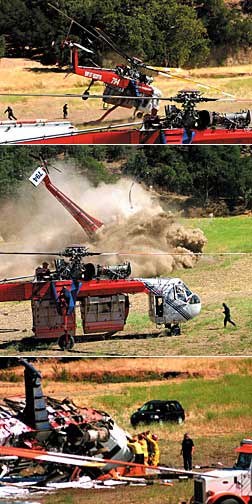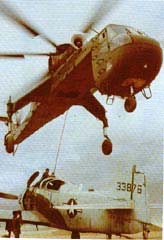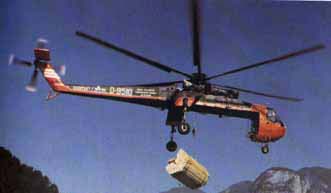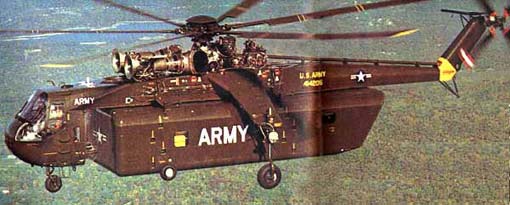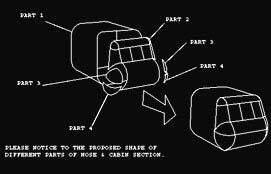

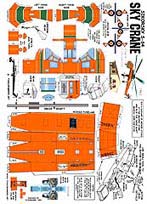
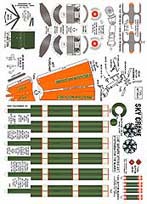
Sikorsky S-64 Sky Crane - $$8.50
The Sky Crane is a fire fighting marvel seen all over the world in the news. Comes with a couple water containers and a EVEN a HOUSE to lug around. Looks great done up in bright orange hanging from the ceiling.. Sikorsky has a winner here and perhaps should get them back into production, yes? Easy and great fun to build !
The Sikorsky S-64 (CH-54) Flying Crane Helicopter
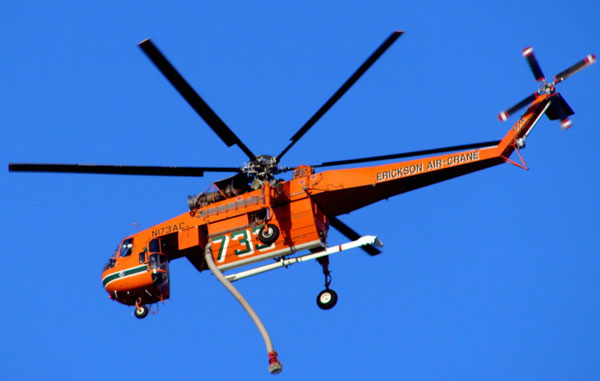
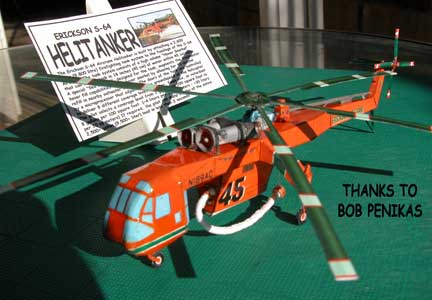 The Sikorsky S-64 (CH-54) Flying Crane Cargo and Erickson Fire-fighting
Helicopter Skycrane's are designed to operate with special containers that can
be carried under their spindly spines. These serve as field hospitals,
command posts or 'universal military pods' (capable of transporting
up to 87 combat-ready troops into the battle zone).
The Sikorsky S-64 (CH-54) Flying Crane Cargo and Erickson Fire-fighting
Helicopter Skycrane's are designed to operate with special containers that can
be carried under their spindly spines. These serve as field hospitals,
command posts or 'universal military pods' (capable of transporting
up to 87 combat-ready troops into the battle zone).
With helicopters becoming more and more specialized, it was perhaps
inevitable that the American armed forces would request one of major
suppliers to design a 'flying crane' like the Soviet Union's mighty
Harke.
The Sikorsky company met this challenge by producing a smaller,
though more manoeuvrable machine called the S-64 Skycrane. Over
100 of these odd looking helicopters have seen service with the
US Army since 1964, a handful more having been bought by commercial
operators.
This model was designed by Shahram Tahmasebi who is an Engineer
in Iran. It took about two months to complete. Since then, as you've
seen on the news, giant fires have been destroying NSW in Australia
and this very helicopter is there dropping material on the fires
water containers to make your S-64 a Fire Fighter!
.....my wife and the kids saw "Elvis the Skycrane" in action the other day down at Bulli (just down the coast at Wollongong). they were staying at a caravan park with her sister and a fire broke out on the mountains behind them. Fortunately nobody was hurt but the main highway was closed for most of the day. Regards, Michael (from Australia during the monster fires
I finished your Fiddlers Green Erickson helicopter just as the fires approached my son's home in Simi Valley, California. Luckily the fire fighting ground crews and helicopters kept the fire away from his and his neighbors homes.
This little display model has a lot of meaning to my family, Thank you Chip
RE: Fiddlers Green Erickson S-64 Fire Fighting Helicopter. The cockpit section had all seams filled with gesso which was sanded and then repainted with acrylics. The entire model was sprayed with three coats of future floor wax. I located from the Internet a picture of a parked S-64 with the fire fighting hose in view. I scratch built the hose by wrapping a strip of letter paper around a brass rod. While the glue was still damp I pushed the hose off the rod down onto the work surface allowing the hose to accordion. The hose collar was made by adding a thin strip round the hose end until it built up to a believable size. The reference photo did not have a good view of the cable attach point under or near the landing gear. That was a guess on my PART. Thin wires were used to support the main rotor blades and landing gear. As a coincidence the day I completed this model the Simi Valley, California fires were demanding the use of the Sikorsky S-64."
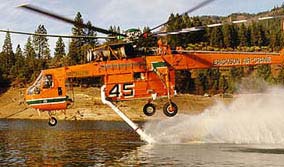
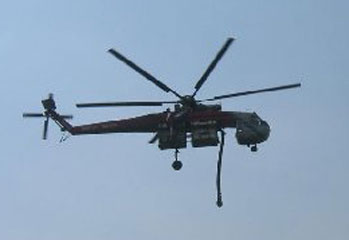
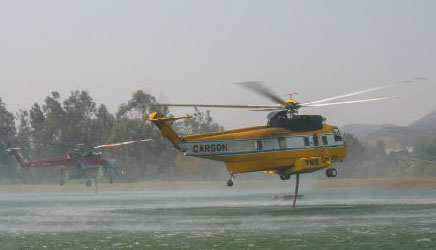
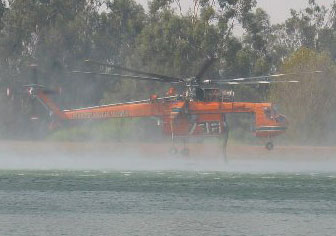
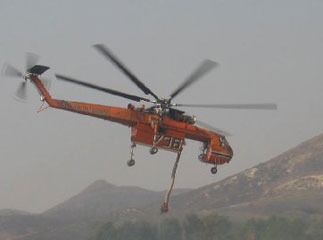
Sikorsky S-64 (CH-54) SkyCrane Helicopter

The requirement for a heavy lift helicopter was growing in the late 1950s, as it became clear that improving technology concerned with the design of rotary-wing dynamic systems, combined with lightweight high powered turbo shaft engines, should make it possible to build aircraft in this category with entirely new standards of performance. It was at about this same time that development of the Boeing Vertol Model 115 (CH-47 Chinook) began, and Sikorsky initiated its own design for a 'flying crane' that was very different in conception.
It consisted of a basic prime mover comprising a long fuselage
beam. At the forward end was suspended a cab to accommodate
a crew of three, plus jump seats for two loaders/technicians;
at the aft end was a tail with the anti-torque rotor on the
left. Above the fuselage two turbo shaft engines, main and intermediate
gear boxes, main rotor and drive shafts were mounted, leaving
the undersurface clear. The tricycle landing gear consisted
of a nose wheel beneath the cab, and main legs on outriggers
to allow the fuselage to straddle a bulky load. A cargo hook
could be lowered by the third, aft-facing crew member.
Sikorsky's concept did not rely purely on the use of cargo hoists, it being intended that the S-64A would straddle interchangeable pods for a variety of purposes. The fundamental idea was linked closely to the road/ship transit of goods in sealed containers: Sikorsky believed that Skycrane's might replace ships over short ranges.
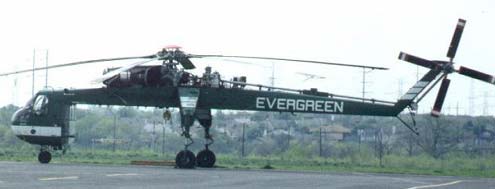 |
 |
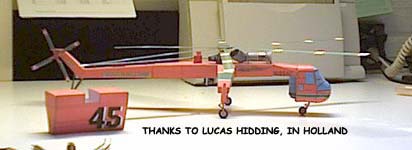 Here are some pictures from the sky crane (made in Holland) it was quite a job to build it. Great job this model. The cockpit gave me a hard time to build but as you can see it came together nice. Lucas Hidding |
 |
Five of the US Army's prototypes were delivered in 1964-5
as production CH-54A Tarhes. The sixth was retained by Sikorsky
to assist FAA certification, 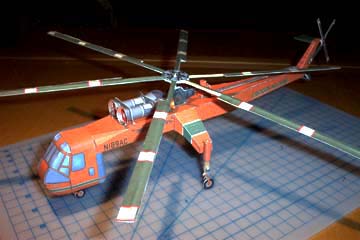 which
was awarded on 30 July 1965.
which
was awarded on 30 July 1965.
Evaluation by the US Army involved deployment in Vietnam with the 478th Aviation Company, where Tarhes performed near miracles in the retrieval of some 380 damaged aircraft, and the transport of such vehicles as bulldozers and road graders, and even armoured vehicles weighing up to 20,000 lb. On one occasion a CH-54A lifted a van containing a total of 90 persons, including 87 combat-equipped troops. Approximately 60 CH-54As were, built. powered by two 4,500-shp (3356-M-) Pratt & Witney T73-P-1 engine.
An improved CH54-B was ordered in November 1968, the first two being accepted in 1969. Improvements included more powerful engines, uprated gearbox, structural strengthening, introduction of a high-lift rotor blade, improved system, and twin wheels added to the main landing gear. In October 1970, such an aircraft lifted a load of 40,780 lb.
Sikorsky built for the US Army a Universal Military Pod. measuring internally 27 ft 5 in x 8 ft 10 in - 6 ft 6 in-high , with a maximum weight of 20,000 lb, for the carriage of troops or field conversion as a surgical unit,command post or communications center
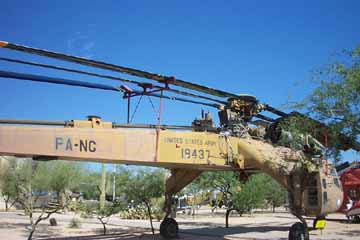 |
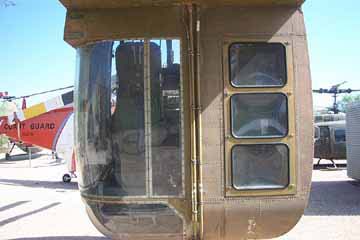 |
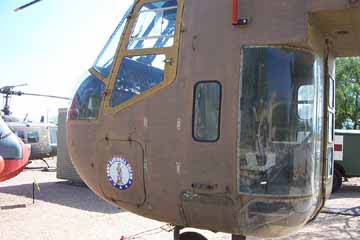 |
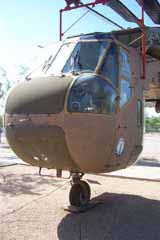 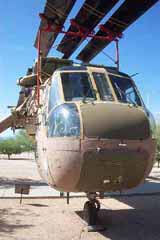 |
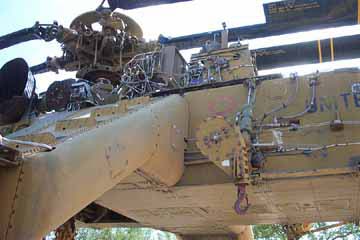 |
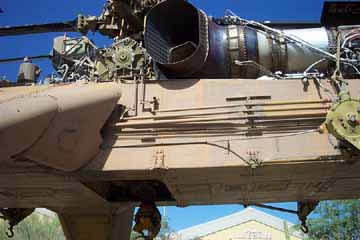 |
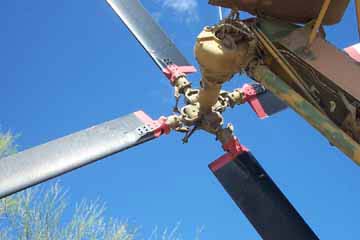 |
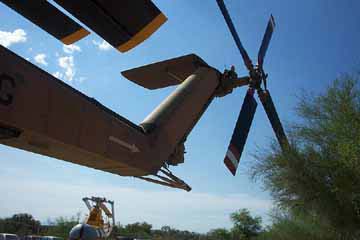 |
The Sky Crane was a most noteworthy program for the Army as it was desperately needed to off load container ships in 'Nam" since "Nam" has no deep water ports to accommodate large freighters.
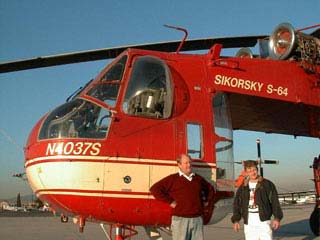 The evolution of the CH-54 began
at Sikorsky Aircraft, Strafford, in approximately 1960 when
Igor Sikorsky envisioned a heavy lift helicopter with the
capability to move large loads through the air. The first
Crane looked somewhat similar to the current version however
it had limited lift capability due to the use of the older
CH-37 drive and engine system.
The evolution of the CH-54 began
at Sikorsky Aircraft, Strafford, in approximately 1960 when
Igor Sikorsky envisioned a heavy lift helicopter with the
capability to move large loads through the air. The first
Crane looked somewhat similar to the current version however
it had limited lift capability due to the use of the older
CH-37 drive and engine system.
This was corrected in the early 60s with the use of 2 Pratt and Whitney J60 engines fitted with free turbines which were designated JFTD 12-4a. These engines turned up 4,400 shaft horsepower each which created a lift capability of 12-5 tons in the later airframe version of the crane. It was this latter version that the Army first procured in 1966 in the quantity of 6 each.
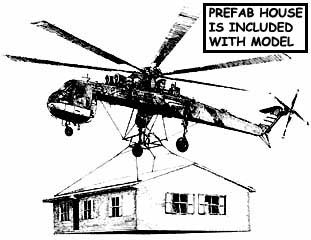
One was retained by Sikorsky for company demonstration purposes and FAA testing under FAR Part 29 to achieve an airworthiness certificate. Meanwhile in 1966, Sikorsky proceeded under Army contract to build the first 6 aircraft as CH-54As. These 6 were, delivered to the Army 1st Calvary at R. Gordon, GA.
Pilot training was limited to operating and controls. The aft facing Pilot was provided with training in the operation of the Breeze-Eastern main cargo hoist and the 4 point suspension systems ID include how to "guillotine" a load if problems were encountered. As an aside, in order to get feel for the time it took to manufacture, assemble, flight test and deliver a crane we must look at the subcontractors tasked with this responsibility.
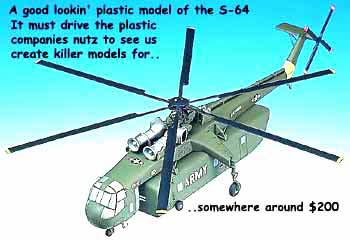
It took a relatively short time to manufacture and assemble the airframe however to complete the crane the dynamic drive system proved to be the pacing production element. From the time Sikorsky placed a main transmission order with Buehler Corporation (Indiana Gear Works) and the main transmission housing castings with Alcoa to the time of delivery of the "kits" to Sikorsky was a period of 18 months. So essentially it took almost 2 years to build a flight worthy crane.
Luckily Sikorsky had a few CH-37 transmissions, which are the same as the CH-54, on hand so the production flow was much shorter. Half way through this production run of 6 the Army held a design review at Sikorsky prior to the second buy of 12 aircraft. This design review resulted in the modification of the rear cylinder shaped aft facing pilot canopy and the extension of the aft portion of the cabin area to form what was then called the "rear porch" - It allowed for more space in the cabin pod for movement and storage.
| |
The difference between the S-64 and CH-54 is in the certification category of the two different models. The S-64 is a "standard category" aircraft. This is the most stringent, and therefore most expensive, certification to obtain from the FAA. All aircraft that carry passengers for hire or operate over populated/congested areas are required to be "standard category." In 1992, Erickson took over the Type Certificate for the S-64, making Erickson the manufacturer and sole support of all S-64's. All Aircranes operated by Erickson are standard category.
The CH-54 is a "restricted category" aircraft.
It was built for the military and was not originally subject
to the FAA certification process until the military sold the
aircraft as "surplus." For the CH-54 to be operated
by civilian operators, who are subject to the FAA regulation,
the FAA the "restricted category" certification.
Restricted category aircraft are not allowed to operate over
populated/congested areas, such as cities, nor are
they allowed to carry passengers for hire. In some circumstances,
restricted category aircraft can be operated just as safely
as standard category aircraft, however, the maintenance and
operating guidelines are more strict for standard category
aircraft.
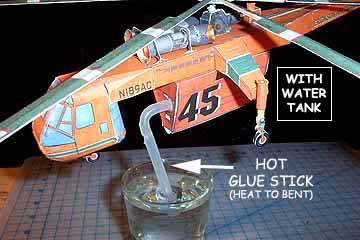 Erickson
Fire Tanker
Erickson
Fire Tanker
The Erickson S-64 Aircrane Helitanker is built by attaching a 2,600 gallon firefighting tank system to the fuselage of the S-64 Aircrane. The tank system consists of a high volume "Hover Snorkel" that can fill the tank in 18 inches of water within 45 seconds. A special "Sea Snorkel", designed for the tank, augments the freshwater hover fill capabilities of the hover snorkel by allowing for 45 second refill in nearby saltwater sources.
The doors of the tank are controlled by a microprocessor that adjusts for the ground-speed of the helicopter to deliver 8 different coverage levels of water, foam mix, or retardant. The pilot selects a coverage level from 1 gallon per 100 square feet to 8 gallons per 100 square feet. If required, the pilot can dump a salvo of the entire 2,500+ gallon load in less than 3 seconds!
The Erickson Air-Crane Helitanker is the most versatile,
powerful, and cost effective aerial fire suppression
system in the world. Since certification in 1992, the
Helitanker has seen worldwide service, fighting fires
in the United States, Canada, Mexico, Borneo, Italy,
Greece, and Turkey.
There are very few "Sikorsky S-64 Skycrane's" in existence. Since Erickson purchased the type certificate for the Skycrane in 1992, they have built 12 "E" models (20,000# lift cap) and 6 "F" models (25,000# lift cap) and have renamed the helicopter the "Erickson S-64 Aircrane". Erickson is the only company in the world that owns and operates the "F" models, having manufactured the first FAA certified models in existence.
The Helitanker has a tank attached to the belly of the "Helitanker and combines the capacity of a tanker plane with the high volume per hour and accuracy of the helicopter. The Helitanker system can precision deliver over 30,000 gallons per hour at a lower cost per gallon than any other system available today. The Helitanker can refill from any water source 18 inches deep in about 45 seconds. Class "A" foam can be injected to each load to the required concentration from the 77 gallon onboard tank.
The patented metered flow system provides 8 different flow rates or coverage levels that are selected by the pilot from the cockpit. The Helitanker can also refill from 5,000 gallon dip tanks filled with water or long term retardant.
Specifications for the Sikorsky S-64/CH-54 SkyCrane
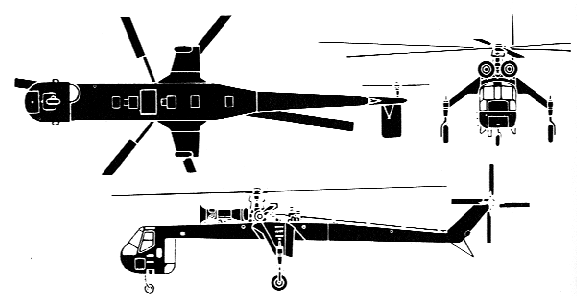 |
Aircraft Crew: 2 pilots and Performance Aircraft Variations |
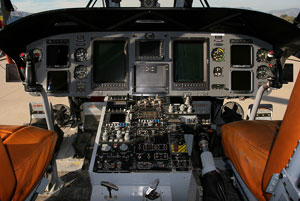 |
Sikorsky S-64 (CH-54) Skycrane Cockpit. |
 |
||
| A: The CH-54 was one of the first modular aircraft. The cabin section, drive train and fuselage were interchangeable units, which could be replaced with little effort in the field. | B: The Tarhe had two engines that drove the main rotor through a central gearbox. The power from either engine could keep the CH-54 aloft in an emergency, but not while carrying a load. | C: Since the CH-54's job was to lift heavy loads rather than fly fast or fight, much of the rotor system was left uncovered, making maintenance easier. |
| D: Designated S-64 Sikorsky, the Tarhe used a modified version of the S-61 Sea King front end mated to a "flying crane" type fuselage. | E: As well as conventional forward-facing positions, the cockpit of the Tarhe also had a station with a large glazed area that faced toward the rear. | F: The undercarriage legs were made very wide and tall so the Tarhe could straddle most loads. Attachment points on the central fuselage could hold pods designed specially for the Tarhe or slung loads carried on straps and cables. |
